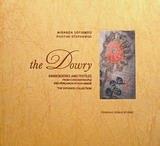THE DOWRY
The art of embroidery is a very ancient art. With needle and stitches, with loom and threads, women revealed their sensitivity, cultivated their imagination, wove their dreams. Vast embroidered fields travelled from East to West, becoming links in a chain of art and communication.
Linen and silk textiles were produced by women’s skillful hands, were transformed into costumes and trousseaus to adorn persons and homes on high-days and holidays. Customs and traditions, joys and sorrows have continued to travel for centuries now in linen and in silk with colourful threads; trees and flowers, carnations, tulips and pansies, motifs enclosing stories and fairytales, pass down the generations and set their seal on cultures old and new, so that they are not forgotten.
Richly-embroidered covers adorn beds, mirrors, chests, cushions and bolsters. Two-sided needlework, difficult but delightful in its execution, harks back to Byzantine times. Silver, pure gold and golden thread, combined with the many colours of dyed silk threads, shimmer like jewels.
The stitches, magical words just to hear, become poems, become embroideries: rizovelonia (stem stitch), trypiti (buttonhole stitch), alysidoti (chain stitch), richti (whipstitch), chyti and travichti (for drawn-thread work), kophto (for cut-work), psathoti (basket stitch), perasti (darning stitch), cevrovelonia (two-sided stitch used on cevres), gazovelonia (double running stitch). Their magic suffuses the women’s handiwork, composing surfaces of precious artistry, poetry and musicality, hymning an entire culture.
Pergamon and Constantinople, Constantinople and Pergamon, the two places represented in the collection. Both also the places of origin of two people, Aristodemos and Myrsine, who joined their lives and who bequeathed to posterity this living treasure-chest of memory.
Constantinople as metropolis of Byzantine minor arts, with a history of imperial patronage of its eponymous weavers and embroiderers, was




 engine
🛠20220503.061449
engine
🛠20220503.061449









